History Blog
|
|
|
|
|
Editor's Note: Thank you to Alison Morris, Hudson River Maritime Museum education intern, for this blog post. For more information about the environmental history of the Hudson Valley view the Rescuing the River online exhibit. The battle for the environmental well being of the Hudson Valley has been a long and hard fought battle. Without Frances “Franny” Reese the physical state of the Hudson Valley would be extremely different today as well as the overall grassroots environmental preservation movement otherwise known as “a movement that uses the people in a given district, region or community as the basis for a political or economic movement. Movements and organizations use collective action from the local level to implement change at the local, regional, national, or international levels.”[1] Spurred by a love of the Hudson Valley region by way of her husband’s family home, Obercreek Farm, set on former dairy farmland in the hamlet of Hughsonville in the Town of Wappinger, Franny joined with other activists to advocate at a local level to preserve the beautiful lands of their homes along the Hudson River.[2] It is important to acknowledge the hard work and contributions of women like Frances Reese and how they spearheaded different grassroots movements that still have significance in preserving the lands of the Hudson River Valley and the river itself. Born in Manhattan in 1917, Frances Reese attended Barnard College, majoring in playwriting and English, and also attended Yale Art School. In 1937, she married her husband Willis Livingston Meier Reese. They both shared interests in conservation and preservation in the Hudson Valley.[3] Frances was a “lifelong advocate and protector of the land and life in the Hudson Valley” and was considered an “environmental trailblazer.”[4] She was “a founder and chairwomen [(1966-1984)] emeritus of the environmental group Scenic Hudson [founded in 1963] and a veteran of the fight to keep a power plant from being built on Storm King Mountain.”[5] Prior to the establishment of Scenic Hudson, a non-profit environmental preservation organization, “grassroots environmental activism did not exist” in the capacity that it does today.[6] Known by many, Franny “was a sparkplug in the movement that began over 40 years ago” ensuring that unbridled development in the Hudson Valley would not go unchecked.[7] She unfortunately passed away in July of 2003 after sustaining fatal injuries in a car accident “on Route 9 near Cold Spring.”[8] In 1965, she and the crew of citizens that she recruited, initially known as the Scenic Hudson Preservation Committee, won legal standing to take on the Federal Power Commission and the developer, Consolidated Edison who were attempting to build, at the time, the largest hydroelectric plant, on Storm King Mountain.[9] Not only would the face of Storm King Mountain be forever changed if Con. Edison's plans were approved, but because of the porous nature of the Hudson Valley's bedrock, there was a high risk that untreated Hudson River water would filter into groundwater, which was and is the source of drinking water for Cornwall, NY.[10] The location of the proposed plant’s construction and water pipeline was also located extremely close to the Catskill Aqueduct.[11] Concerns were raised about the potential impacts of blasting, and how it could interrupt or damage the aqueduct, significantly or completely interrupting the water supply to New York City.[12] This decision came to be known as the “Storm King Decision.”[13] Stopping this development, “Frances and her committee of like-minded individuals achieved important precedent in the national environmental movement, establishing the principle that citizens could intervene in court cases affecting the environment.”[14] She, and those who would become the Scenic Hudson founders, opposed such a development as it would deface the famous peak of Storm King Mountain and harm the ecology of the Hudson River.[15] Language from this case would go on to be included in the 1969 National Environmental Policy Act.[16] In similar legislation, like the 1969 National Environmental Policy Act, there also came the establishment of the Environmental Protection Agency that mandated environmental impact studies for construction projects.[17] The Clean Water Act of 1977 and the Superfund Law of 1980 also secured passage in the legislation through precedent set by the Storm King Decision.[18] During Franny’s lifetime and involvement in Scenic Hudson which eventually became the organization that we know today, “she […] oversaw the group's legal and educational work. She attended board meetings[...] and remained cheerfully active as a strategist for policy and litigation, a liaison to state and federal governments and one of the organization's leading fund-raisers.”[19] You might ask, how might the environmental movement and land preservation directly impact the Hudson River? Well, it's important to look at particular locations along the Hudson that would not be the way they are today without Franny Reese’s direct contributions and actions. The Franny Reese State Park, Highland, New York,, which is a recognized by New York State Parks, Recreation, and Historic Preservation as well as the Palisades Interstate Park System, is one of these very locations. The very organization that Franny helped in establishing, Scenic Hudson, manages the grounds of this park to this day. Through its official recognition and ultimate protection under these organizations, the natural landscapes and ecosystems of the Hudson River Valley are allowed to flourish. Through the very establishment of Franny Reese State Park, Scenic Hudson was able to “conserve this magnificent bluff-top forest [and] to prevent a massive residential development from destroying it.”[20] Industrial development that would otherwise negatively impact the land through the destruction of crucial ecological communities as well as pollution is blocked from occurring. It is with state parks, like Franny Reese, that the natural views and integrity of the Hudson River Valley and the River itself are maintained. As the Franny Reese State Park has direct access to the Hudson River, it also preserves the riverfront land, and the river itself directly, through its allocation of environmentally preserved land through the park systems and non-profit organizations like Scenic Hudson. The very creation of parks leads to the ability for non-profit organizations, like Scenic Hudson, to conserve important ecological environments and allow for individuals to explore the natural treasures of the Hudson Valley. The very ability for people to be able to connect with nature is one of the important motivating pillars for Scenic Hudson. Movements like environmental conservation go hand in hand with many other women’s movements. Franny Reese’s involvement in such critical environmental projects and decisions in the Hudson Valley provides insight into the larger picture of Women's involvement in crucial public change organizations and efforts. Environmental conservation movements empower women. In many instances, women are often subordinated under men and their voices largely go unheard or are completely blocked. Environmental conservation gives women an outlet to enact meaningful and lasting change in their communities. This ultimate growth of women's participation in public policy contributes to the ultimate increase in women’s involvement in everyday institutions of society and life. According to the organization IUCN, “women often have deep knowledge of their local ecosystems, and are habitually the primary caregivers and providers for their families. They are more likely to be directly impacted by environmental degradation, particularly in developing countries where they may rely heavily on natural resources for their livelihoods.”[21] When looking at the role that the environment plays in the larger picture of established societies, it is easier to recognize the interconnectedness between environmental conservation and political activism and change. Below are two critically important quotes from the IUCN that illuminate the necessity of environmental conservation and activism in the scheme of women’s rights and empowerment: “Women's participation in environmental policy and action is not only a matter of equity and justice, but also essential for achieving sustainable development. The 2030 Agenda for Sustainable Development, [...] states that ‘gender equality is not only a fundamental human right but a necessary foundation for a peaceful, prosperous, and sustainable world.’”[22] “Empowering women and amplifying their voices in environmental policy and action is crucial to achieve sustainable development and address the urgent environmental challenges facing the world today. It requires recognizing the gender inequalities that exist, and working to overcome them through inclusive and gender-responsive policies and programs. It also requires valuing women's knowledge and expertise, and supporting their leadership and entrepreneurship. Only by doing so can we ensure that the environmental policies and actions we take are effective, equitable, and sustainable for all.”[23] The undeniable contributions of Franny Reese reveal the larger story of how land conservation was a crucial aspect of public change/advocacy for women’s rights and the maintenance of the Hudson Valley and Hudson River. [1] “Grassroots,” Wikipedia, February 24, 2024. https://en.wikipedia.org/wiki/Grassroots. [2] Alexandra Zissu, “How Franny Reese Fought Con Edison and Saved Storm King Mountain,” Times Union, Accessed March 6, 2024. https://www.timesunion.com/hudsonvalley/outdoors/article/how-franny-reese-fought-coned-saved-storm-king-16972561.php. [3] Wolfgang Saxon, “Frances Reese, 85, Defender of Hudson Valley,” The New York Times, July 9, 2003. https://www.nytimes.com/2003/07/09/nyregion/frances-reese-85-defender-of-hudson-valley.html. [4] “Parks & Trails New York: What’s in a Name? Who Was Franny Reese?” Parks & Trails New York, Accessed March 6, 2024. https://www.ptny.org/news-and-media/you-gotta-have-friends/2020/04/whats-name-featuring-franny-reese-state-park. [5] Wolfgang Saxon, “Frances Reese, 85, Defender of Hudson Valley,” The New York Times, July 9, 2003. https://www.nytimes.com/2003/07/09/nyregion/frances-reese-85-defender-of-hudson-valley.html. [6] Steve Rosenberg, “Preservation and Perseverance: Pillars of Scenic Hudson’s Grassroots Legacy,” Hudson River Maritime Museum, Accessed March 6, 2024. https://www.hrmm.org/history-blog/preservation-and-perseverance-pillars-of-scenic-hudsons-grassroots-legacy. [7] Ibid [8] Ibid [9] Wolfgang Saxon, “Frances Reese, 85, Defender of Hudson Valley,” The New York Times, July 9, 2003. https://www.nytimes.com/2003/07/09/nyregion/frances-reese-85-defender-of-hudson-valley.html. [10] “Powering The Hudson: Storm King,” Hudson River Valley Heritage, accessed March 20, 2024, https://omeka.hrvh.org/exhibits/show/rescuing-the-river/powering-the-hudson/storm-king. [11] Ibid. [12] Ibid. [13] Alexandra Zissu, “How Franny Reese Fought Con Edison and Saved Storm King Mountain,” Times Union, Accessed March 6, 2024. https://www.timesunion.com/hudsonvalley/outdoors/article/how-franny-reese-fought-coned-saved-storm-king-16972561.php. [14] Wolfgang Saxon, “Frances Reese, 85, Defender of Hudson Valley,” The New York Times, July 9, 2003. https://www.nytimes.com/2003/07/09/nyregion/frances-reese-85-defender-of-hudson-valley.html. [15] Susan Hereth, “Franny Reese: A Hero For the Hudson Valley,” Accessed March 6, 2024. https://www.scenichudson.org/wp-content/uploads/legacy/u2/freesebooklet.pdf [16] Wolfgang Saxon, “Frances Reese, 85, Defender of Hudson Valley,” The New York Times, July 9, 2003. https://www.nytimes.com/2003/07/09/nyregion/frances-reese-85-defender-of-hudson-valley.html. [17] Ibid. [18] Ibid. [19] Ibid. [20] Susan Hereth, “Franny Reese: A Hero For the Hudson Valley,” Accessed March 6, 2024. https://www.scenichudson.org/wp-content/uploads/legacy/u2/freesebooklet.pdf [21] Srinivasan Balakrishnan, “Empowering the Unheard: Why Women’s Voices Are Crucial in Environmental Policy and Action,” IUCN, accessed March 3, 2023. https://www.iucn.org/story/202303/empowering-unheard-why-womens-voices-are-crucial-environmental-policy-and-action. [22] Ibid. [23 Ibid. Bibliography Allen, Maeve. “5 Inspiring Women Who Made History in the Hudson Valley.” Hudson Valley Magazine, July 19, 2023. https://hvmag.com/life-style/hudson-valley-inspiring-women/. Balakrishnan, Srinivasan. “Empowering the Unheard: Why Women’s Voices Are Crucial in Environmental Policy and Action.” IUCN, March 3, 2023. https://www.iucn.org/story/202303/empowering-unheard-why-womens-voices-are-crucial-environmental-policy-and-action. “Franny Reese State Park.” Scenic Hudson, June 28, 2023. https://www.scenichudson.org/explore-the-valley/scenic-hudson-parks/franny-reese-state-park/. “Grassroots.” Wikipedia, February 24, 2024. https://en.wikipedia.org/wiki/Grassroots. Hereth, Susan. “Franny Reese: A Hero For the Hudson Valley.” Accessed March 6, 2024. https://www.scenichudson.org/wp-content/uploads/legacy/u2/freesebooklet.pdf “Parks & Trails New York: What’s in a Name? Who Was Franny Reese?” Parks & Trails New York. Accessed March 6, 2024. https://www.ptny.org/news-and-media/you-gotta-have-friends/2020/04/whats-name-featuring-franny-reese-state-park. Rosenberg, Steve. “Preservation and Perseverance: Pillars of Scenic Hudson’s Grassroots Legacy.” Hudson River Maritime Museum. Accessed March 6, 2024. https://www.hrmm.org/history-blog/preservation-and-perseverance-pillars-of-scenic-hudsons-grassroots-legacy. “Powering The Hudson: Storm King.” Hudson River Valley Heritage. Accessed March 20, 2024. https://omeka.hrvh.org/exhibits/show/rescuing-the-river/powering-the-hudson/storm-king. Saxon, Wolfgang. “Frances Reese, 85, Defender of Hudson Valley.” The New York Times, July 9, 2003. https://www.nytimes.com/2003/07/09/nyregion/frances-reese-85-defender-of-hudson-valley.html. Zissu, Alexandra. “How Franny Reese Fought Con Edison and Saved Storm King Mountain.” Times Union. Accessed March 6, 2024. https://www.timesunion.com/hudsonvalley/outdoors/article/how-franny-reese-fought-coned-saved-storm-king-16972561.php. AuthorAlison Morris is a senior at Marist College, majoring in History with a double minor in Music and Women, Gender, & Sexuality Studies. Their areas of interest in History include South East Asia, particularly that of China and Japan, as well as World War II era History from global & American perspectives. Currently, Alison is an education intern at the Hudson River Maritime Museum, working on various social media endeavors for Solaris and HRMM's various tour offerings, as well as curriculum development and support for homeschool lessons on Indigenous people of the Hudson Valley & their maritime history. Alison is a Hudson Valley native who took on this internship with HRMM to broaden their historical understanding of and outreach to the Hudson Valley. If you enjoyed this post and would like to support more history blog content, please make a donation to the Hudson River Maritime Museum or become a member today!
0 Comments
Editor's note: The following text is from the 1819 Letters to his father by Henry Meigs describing his life in then rural Greenwich Village. Thank you to Contributing Scholar George A. Thompson for finding, cataloging and transcribing this article. The language, spelling and grammar of the article reflects the time period when it was written. 1819: N. York, Feby 6th, 1819 Dear father. Since I last wrote you, Julia + I have decided on placing our tent in the Country as we call it for the ensuing summer. Where we can live much more economically and deliciously. *** It is a decent, convenient house immediately on the North River Margin, with the beach where we can bathe, at our door. Green slopes covered with thrifty Apple trees from the road to the River, a garden large enough to exercise Henry + I. We have all this for less than I have been used to pay these 10 years, and the distance from my office is only 13000 feet! I shall bring my dinner in my Pocket in the morning + retreat at night from our noisy, noisy town and when the apple trees are dipped in flowers, I shall be able to relish Homer. [passage in Greek] *** New York, March 14, 1819. My dear brother. ** You know when one owns an apple tree, what pains one must be at to keep the young rascals from stealing all the fruits. All one has of it is to consider that apple tree owning is a troublesome business *** N. York, April 18, 1819.Dear father - Yesterday we had a very interesting display of Electricity between two and three of P. M. [the lightning followed an all-day gale; a sketch-map showing that most of the lightning strikes were on the East River, below Wall-street] My country house is so situated as to receive the full force of blowing weather. So that in the stormy nights Julia + I have been delightfully lulled to sleep by the roar of wind + rain attended with that still more pleasant music [passage in Greek]. I assure you that [illegible] waves three feet hight roll on our sand beach most agreeably. *** The weather has been damp but we are all free from colds. Julia thinks the bank of the river is drier than our City brick vaults. The passing of the river boats of all sorts is a constant amusement + interest. When the wind blows heavy you watch as far as you can see, some bumpkin schooner or sloop whose press of sail threatens him every moment with a keel up + you admire some clean painted vessel with close reefs reaching hand over hand in the wind's eye towards the Metropolis and mark at every half [?] minute the spray fly from stem to stern thus [a sketch] and when she comes about we have all the noise of the sails [illegible] shivering in the blast. Henry Meigs, Letters. N-YHS; Between two and three o'clock on Saturday last, the city was visited by a storm of rain and hail, accompanied with considerable thunder and lightning. The schooner Thames, lying at Coffee house slip, was struck by the lightning, and was on fire for a considerable time, and much damaged; three men on board were hurt by the lightning, and sent to the hospital. *** National Advocate, April 19, 1819, p. 2, col. 3; [a destructive thunderstorm] N-Y E Post, April 19, 1819, p. 2, col. 3, from Mer Adv & Gaz; N-Y D Advertiser, April 19, 1819, p. 2, cols. 1-2 New York, April 25, 1819. Dear father - *** I am at work in my Garden at about sunrise + continue for two hours. Yesterday + the day before I dug up and raked over neatly, each morning about 800 superficial feet: about as much as a common labourer would do in a whole day. It is after such labour that I take pleasure in a good shave, wash, clean shirt, &c. breakfast, 2 mile walk + then sitting at my desk with pen. Henry Meigs, Letters. N-YHS.- a plan of his grounds and house: 200 feet along the river, 260 feet deep to the road; a house apparently with porches front & back; a barn, cow shed & fowl-house; a garden, approximately 100 x 130; apple & other fruit trees; the "quidnunc necessarius" (sp?) at the river's edge] - Henry Meigs, Letters. N-YHS, undated, filed between letters of May 9 and May 12, 1819 [fish in the market sell so cheaply that he tends his garden rather than fish for flounder from "the timber raft now in front of my door"; letter of May 16, 1819] One of the greatest evils of our London is, the vile quality of the water, which is obviously produced by the 1000s of Cloacinious (sp?) structures on the surface. I moved one mile from the Coffee house 8 years ago, principally, to obtain better water, for it may be observed at every street as you remove from the South end of our City, that the water becomes better. *** In the City, our tea kettle became encrusted with stony matter to the thickness of nearly 1/4 Inch in some months. *** I met Burr day before yesterday, and his appearance, so sprightly, induced me to remark to him that he had lost nothing of the appearance of health in the last 10 years. He replied smilingly "I presume, -- I have no doubt that I shall live all the days of my life! that is my philosophy!" *** This has been as usual (Sunday) a great River sloop day. They fill up cargo by Saturday all along the Hudson and improve Sunday to reach our market, -- baaing, cackling + horse blowing it -- along with calves, sheep, fowl, fresh butter et omnia cetera farmalia. I have to day counted 8 to 10 frequently in sight, in 15 minutes. *** Henry Meigs, Letters. Letter of May 23, 1819. N-YHS. ["whole dozens of boys" come to swim in the river near his house] I am sitting in my largest room looking thro the west windows on the opposite shore. Staten Island, the river, the sloops, the boys swimming. Henry Meigs, Letters. Letter of June 6, 1819. Henry Meigs, Letters to his father. New-York Historical Society. 1819-04-18 -- Henry Meigs, Letters to his father. At New-York Historical Society. Henry Meigs, coun. & nota, 16 Nassau, h. 43 Franklin (Longworth's, 1818/19);. Henry Meigs, coun. & nota, 16 Nassau, h. Greenwich (Longworth's, 1819/20) 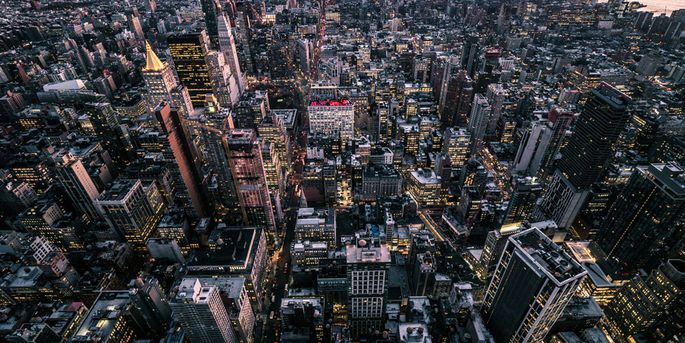 A more modern view of the former farmland. https://www.google.com/url?sa=i&url=https%3A%2F%2Fwww.propertynest.com%2Fblog%2Fcity%2Fgreenwich-village-manhattan-review-neighborhood-moving-guide%2F&psig=AOvVaw3pxW29IOBs6lnJaQsSKSn9&ust=1692726439999000&source=images&cd=vfe&opi=89978449&ved=0CA8QjRxqFwoTCKiYr8an7oADFQAAAAAdAAAAABAd If you enjoyed this post and would like to support more history blog content, please make a donation to the Hudson River Maritime Museum or become a member today!
Editor's note: The following text is an except from "Terrible Explosion"., reprinted in the Queensland Australia newspaper "Maryborough Chronicle, Wide Bay and Burnett Advertiser." Thank you to Contributing Scholar George A. Thompson for finding, cataloging and transcribing this article. The language, spelling and grammar of the article reflects the time period when it was written. TERRIBLE EXPLOSION. (From the Special Correspondent of the "New York Tribune.") Newburgh, June 3, 1868. Dwellers along the Hudson River for a distance of 30 miles north and south of this city were startled at six o'clock this morning by the shaking of their houses, the rattling of windows, and two distinct, heavy, rumbling reports. Many supposed that two shocks of an earthquake had taken place, and rushed from their houses in excitement. The cause of the excitement was the explosion of 10,000 pounds of powder, and the blowing up of two powder mills, owned by Messrs. Smith and Rand, about four miles west of this city, on the South Plank Road, leading to Walden, Orange County. A visit to the spot revealed the following facts: The graining mill, where the first explosion occurred, was a sort of double building, 20 by 16 feet, built of stone, with wooden sides and one story high. It stood about one hundred feet from the main road, separated from the latter by a clump of trees. In it at the time of the explosion was five tons of powder, the most of it being in the grain. The glazing mill was situated across a dam, about one hundred feet from the graining mill, and was about fifteen feet in diameter, octagonal in form, and was in no way connected with the graining mill. In it at the time of the explosion was about a ton of powder. At exactly six o'clock this morning the graining mill blew up, the fire shooting with great violence across the dam to the glazing mill, and in five seconds thereafter that was also blown to fragments. The scene is described as being fearfully grand. The foundation of the graining mill was scooped out as though with a shovel. Huge sticks of timber were thrown through the air for a quarter of a mile, small trees were uprooted, and hurled a long distance; while larger and older trees were entirely stripped of leaves and branches; and their trunks blackened and charred. At the foot of trees numbers of dead birds were found, having been instantly killed by the powerful shock. A large iron shaft four inches in diameter, led from the graining mill to another building on the south side of the road. It was seventy-five feet long. The end nearest to the building which exploded was bent almost double; while a portion of the shaft fifteen feet long was broken off and hurled over 400 yards from the scene. For more than a quarter of mile the ground is strewn with the debris. Huge timbers, blackened and splintered with powder, heavy and long limbs of trees, and in many instances whole trees, ragged and torn, block the paths and roads leading to spot. A storage building on the south side of the road, distant all of 150 yards from the graining mill, was badly shattered. It contained three tons of powder in kegs. The large door at the main entrance was blown off, the sides of the building crushed in, and the roof greatly damaged. Fortunately, the powder in the building did not ignite. Of course, as soon as the danger consequent upon the terrific explosion had passed away, there was a rush to ascertain if anyone was killed. At the time of the occurrence there, there was only one man in the graining-mill and none in the others. His name was Adam Schosser [?], a German. He was employed as Messrs. Smith and Rand's service for several years, and was considered perfectly trust-worthy. He had often asserted that he knew his business too well to be blown up. He was undoubtedly blown high in air, some suppose 1000 feet. His head and shoulders were found at a distance of 500-yards from the spot where the explosion occurred, mangled and torn beyond recognition. An arm was found, lodged in the crutch of a tree, while for a distance of a quarter of a mile pieces of flesh and parts of his limbs were found strewn along the ground and hanging to limbs of trees. All the parts found were collected and placed in a barrel. Coroner Thomas Bingham of Newburgh, who arrived soon after the occurrence, empannelled a jury, and an inquest was held over about two-thirds of the body, the jury returning a verdict in accordance with the facts. The shock in this city was terrific. Houses were shaken to their foundation and in many places windows were shattered. Standing in one of the streets and looking toward the spot where the explosion occurred a huge column of smoke and dust was seen to shoot upward fully 1000 feet into the heavens, presenting a scene grand beyond description. A vast ring of smoke whirled far up and gradually widening in area, was a sight never witnessed before in this vicinity. The concussion started persons who were thus slumbering, in many cases arose trembling and anxious to know the cause. For a distance of ten miles back, on the opposite side of the river, the explosion was distinctly heard, while West Point, Peekskill, Sing Sing and Poughkeepsie the report was also noticed. Three years ago a similar explosion took place at the same spot; when one man was killed. Had the explosion of this morning occurred one hour later, the loss of life would have been fearful, as at 7 a.m. the twenty men employed at the works commence labor, when, in all probability, every one of them would have been blown to pieces.-"Maryborough Chronicle, Wide Bay and Burnett Advertiser" (Queensland, Australia.), September 22, 1868 If you enjoyed this post and would like to support more history blog content, please make a donation to the Hudson River Maritime Museum or become a member today!
On the bitter cold winter night of December 16, 1835 a fire caused by a burst gas pipe ignited by a coal stove broke out in lower Manhattan and burned for hours. The gale-force winds spread the flames rapidly across 17 city blocks. The frozen East River and Hudson River hampered the fire-fighting efforts. More than 600 wood frame buildings were destroyed. The Hudson River Brick Industry flourished during the rebuilding process as more durable brick replaced the former wooden buildings. Watch at www.hrmm.org/lecture-series for upcoming Follow the River Lectures in 2023 to learn more about the Great Fire and the Brick Industry. Come visit the brick exhibit at the Hudson River Maritime Museum. Listen as The History Guy gives more details. If you enjoyed this post and would like to support more history blog content, please make a donation to the Hudson River Maritime Museum or become a member today!
In the spirit of Earth Day last week, for today's Media Monday, we are sharing information about dam removal in the Hudson River Valley. According to the NYS Department of Environmental Conservation, the Hudson River watershed has more than 1,600 dams and as many as 20,000 culverts. Most of these are remnants of the Hudson Valley's industrial past. Although dams can play an important role in flood mitigation and hydroelectric power generation, they also serve as barriers to migratory fish such as herring who swim up the Hudson's tributary creeks and streams to spawn. Of particular concern are abandoned dams in poor repair. In 2019, Riverkeeper worked with documentary filmmaker Jon Bowermaster to produce the short documentary film, "Undamming the Hudson River," all about the science and efforts behind removing abandoned and unnecessary barriers to the watershed. Watch below for the full film. Learn more about dam removal efforts in the Hudson River watershed:
If you enjoyed this post and would like to support more history blog content, please make a donation to the Hudson River Maritime Museum or become a member today!
Today is Earth Day, and what better way to celebrate than with a roundup of amazing Hudson River environmental history? Read on to learn more about some of the people and organizations that have had a big impact on the health of the Hudson River, and the American environmental movement. 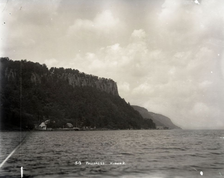 Women in the Forest: Tree Ladies and the Creation of the Palisades Interstate Park On September 22, 1897, Mrs. Edith Gifford boarded a yacht on the Hudson River along with other members of the New Jersey State Federation of Women’s Clubs (NJSFWC) and male allies from the American Scenic and Historic Preservation Society (ASHPS). The goal of this riverine excursion was to assess the horrible defacement of the Palisades cliffs by quarrymen, who blasted this ancient geological structure for the needs of commerce—specifically, trap rock used to build New York City streets, piers, and the foundations of new skyscrapers. All on board felt that seeing the destruction firsthand, with their own eyes, was the first step in galvanizing support for a campaign to stop the blasting of the cliffs. 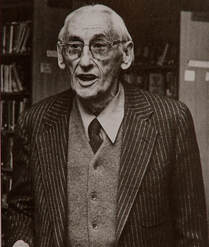 Remembering Theodore Cornu: Unacknowledged Father of Environmentalism Theodore J. Cornu was born in New Jersey to a Swiss mother and father, the latter of whom soon abandoned Cornu, his mother and siblings. The young Cornu demonstrated an affinity for art early on and eventually found his way to a Manhattan engrossing studio, where he soon became employed as an “engrosser” hand lettering diplomas and other commemorative documents. Canoeing was popular amongst his engrossing colleagues, which led him to the boating community in Ft. Washington. His love for canoeing seems to have catalyzed his interest in both the Hudson River and Native American customs. 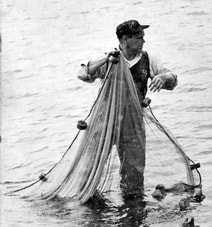 Robert Boyle, Hero of the Hudson If ever a man loved a river, Robert Hamilton Boyle Jr. loved the Hudson — and he was not afraid to shout his love from the rooftops. In his classic text, The Hudson River: a Natural and Unnatural History (1969), Boyle makes his feelings abundantly clear with the book’s very first line. “To those who know it,” wrote Boyle, “the Hudson River is the most beautiful, messed up, productive, ignored and surprising piece of water on the face of the earth. There is no other river quite like it, and for some persons, myself included, no other river will do. The Hudson is the river.” 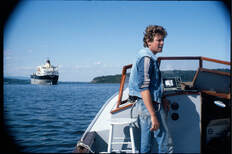 The Origins of Riverkeeper In March 1966, a small group of recreational and commercial fishermen, concerned citizens and scientists met at a Crotonville American Legion Hall intending to reverse the decline of the Hudson River by reclaiming it from polluters. With them was Robert H. Boyle, an angler and senior writer at Sports Illustrated, who was outraged by the reckless abuse endured by the river. At the group’s initial meeting, Boyle announced that he had stumbled across two forgotten laws: The Rivers and Harbors Act of 1888 and The Refuse Act of 1899. These laws forbade pollution of navigable waters in the U.S., imposed fines for polluters, and provided a bounty reward for whoever reported the violation. After listening to Boyle speak, the blue-collar audience agreed to organize as the Hudson River Fishermen’s Association, and dedicate themselves to tracking down the river’s polluters and bringing them to justice. 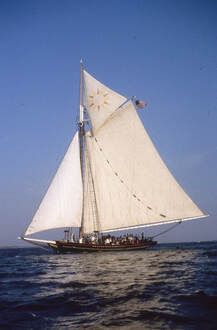 History of the Sloop Clearwater Most people familiar with CLEARWATER know the sloop was the brainchild of the late American folk legend and activist Pete Seeger. Pete was an idealist and an optimist. He once wrote, “There is a little Don Quixote in all of us.” You couldn’t tell him something couldn’t be done. But when you take a closer look at CLEARWATER’s story, it’s a miracle the boat was ever built at all. At the time CLEARWATER was built, the “tall ship revival” was still a decade or two away. Yes, the first Operation Sail brought tall ships from around the world to New York Harbor in 1964, but no one was building new tall ships with one or two exceptions. There were vessels built that were replicas of specific ships, such as the MAYFLOWER II, launched in 1956, and the HMS BOUNTY, launched in 1962 and built specifically for the filming of Mutiny on the Bounty. But to form a new not-for-profit to build a replica of a type of ship -- not even a famous historic ship? Nobody was doing that. Seeger and the fledgling Clearwater organization were ahead of the curve. 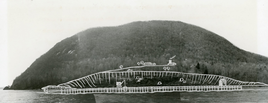 Preservation and Perseverance: Pillars of Scenic Hudson's Grassroots Legacy Scenic Hudson improves the health, quality of life and prosperity of Hudson Valley residents by protecting and connecting them to the Hudson River and the region beyond. Ever responsive to the changing pulse of the region, the ways we achieve our mission are always evolving. Our work today builds upon more than five decades of advocacy and citizen engagement. When Scenic Hudson was founded in 1963, grass-roots environmental activism did not exist as it does today. Con Edison’s plan to construct a hydroelectric plant on the face of majestic Storm King Mountain in the Hudson Highlands changed that. If you'd like to learn more about the role of the Hudson River in American environmentalism, check out our online exhibit "Rescuing the River: 50 Years of Environmental Activism on the Hudson," which is now a traveling exhibit and currently on view at the Newburgh Free Library. If you enjoyed this post and would like to support more history blog content, please make a donation to the Hudson River Maritime Museum or become a member today!
Happy Earth Week! Wednesday is Earth Day, so today's Media Monday features a 1941 Encyclopaedia Britannica Film describing the sources of city water supplies with a focus on the New York City Water system from the Catskill Mountains reservoirs to the faucets of New York City. Video courtesy of archive.org.
Last fall we hosted author and historian Frank Almquist for a discussion of the construction of the Ashokan Reservoir as part of our Follow the River Lecture Series. You can watch the recorded lecture below:
Want to know more? Check out these previous blog posts about New York's water supplies:
If you enjoyed this post and would like to support more history blog content, please make a donation to the Hudson River Maritime Museum or become a member today!
For Women's History Month, we're revisiting all the ways in which women have had an impact on the Hudson River. Today, we're highlighting a lecture we hosted in 2020 - only our second virtual lecture ever! - with conservation expert Cara Lee. In "Women and the Revival of the Hudson River," Cara discusses how the Hudson River has had a revival in the last sixty years and the roles that many women have played in this epic story, including the ways they created important narratives about the river against the backdrop of societal change. Cara is accompanied by special guest Aidan Mabey. To learn more about the environmental history of the Hudson River more generally, check out our online exhibit, "Rescuing the River: 50 Years of Environmental Activism on the Hudson." You can also read about the women of the Palisades Interstate Parks Commission in Jeanne Haffner's "Women in the Forest: Tree Ladies and the Creation of the Palisades Interstate Park." For more about other remarkable women in the Hudson Valley, check out this article by Scenic Hudson. For more lectures, check out our Follow the River Lecture Series, sponsored in part by Rondout Savings Bank. If you enjoyed this post and would like to support more history blog content, please make a donation to the Hudson River Maritime Museum or become a member today!
View this fascinating video detailing the history of the Esopus Creek. The history and community of Saugerties, New York, is interpreted through its relationship to the Esopus Creek and Hudson River. Directed by Katie Cokinos and Guy Reed. Original Music: Carl Mateo. Camera and Editorial: Alex Rappoport. If you enjoyed this post and would like to support more history blog content, please make a donation to the Hudson River Maritime Museum or become a member today! In today's Media Monday post, former Hudson River Maritime Museum intern and current DEC educator Audrey Trossen tells us all about the geology of the Mid-Hudson Valley, including deposits that enabled the limestone and brickmaking industry. Audrey wrote about the brick industry and the Haverstraw Clay Pit Disaster here on our blog during her internship. Read her article here! And then watch Audrey in the video below. For an even deeper look at the impact of glaciers and the Ice Age on the Hudson Valley, check out our virtual lecture with scientists and authors Bob and Johanna Titus: If you enjoyed this post and would like to support more history blog content, please make a donation to the Hudson River Maritime Museum or become a member today!
|
AuthorThis blog is written by Hudson River Maritime Museum staff, volunteers and guest contributors. Archives
July 2024
Categories
All
|
|
GET IN TOUCH
Hudson River Maritime Museum
50 Rondout Landing Kingston, NY 12401 845-338-0071 [email protected] Contact Us |
GET INVOLVED |
stay connected |
